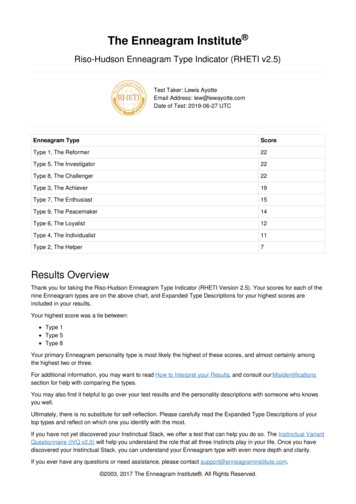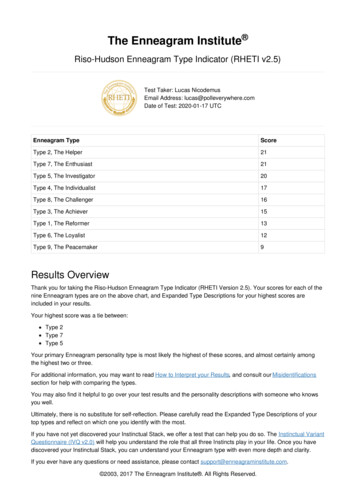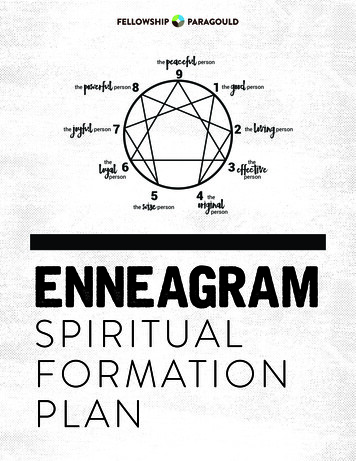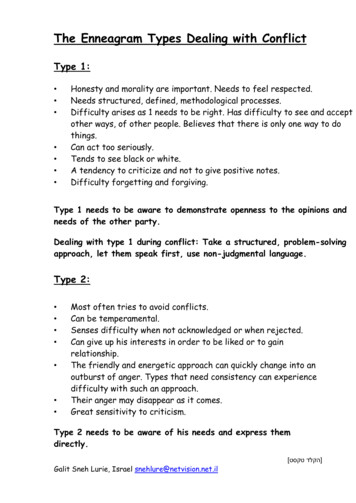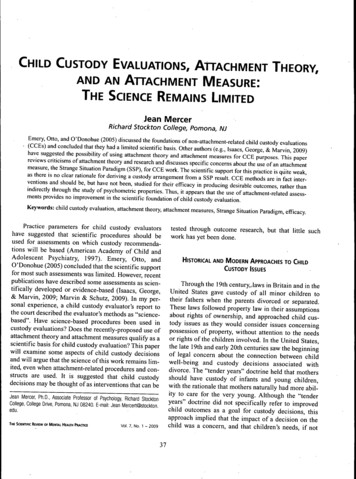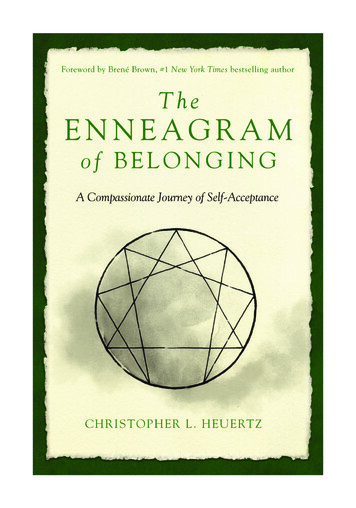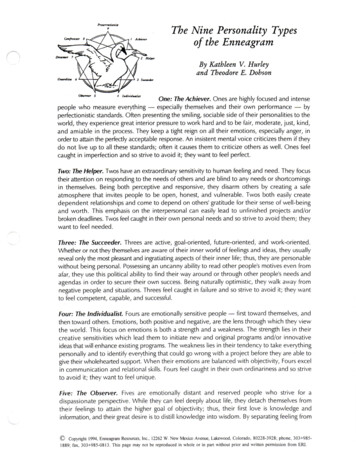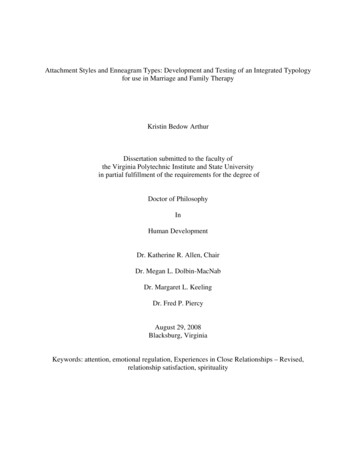
Transcription
Attachment Styles and Enneagram Types: Development and Testing of an Integrated Typologyfor use in Marriage and Family TherapyKristin Bedow ArthurDissertation submitted to the faculty ofthe Virginia Polytechnic Institute and State Universityin partial fulfillment of the requirements for the degree ofDoctor of PhilosophyInHuman DevelopmentDr. Katherine R. Allen, ChairDr. Megan L. Dolbin-MacNabDr. Margaret L. KeelingDr. Fred P. PiercyAugust 29, 2008Blacksburg, VirginiaKeywords: attention, emotional regulation, Experiences in Close Relationships – Revised,relationship satisfaction, spirituality
Attachment Styles and Enneagram Types: Development and Testing of an Integrated Typologyfor use in Marriage and Family TherapyKristin Bedow ArthurABSTRACTThis study developed and tested a new typology for use in Marriage and Family Therapy. Thetypology was created by integrating two already established typologies currently in use in MFT,the attachment style typology and the Enneagram typology. The attachment typology is based onattachment theory, a theory of human development that focuses on how infants and adultsestablish, monitor and repair attachment bonds. Differences in attachment style are associatedwith different kinds of relationship problems. The Enneagram typology categorizes peopleaccording to differences in attention processes. These differences in attention processes are alsoassociated with different kinds of relationship problems, but also with different kinds of spiritualproblems and talents. Support was found for both the internal and external validity of theintegrated typology. The results were discussed in terms of relationship satisfaction andattachment based therapy. Implications for using the integrated typology to address spirituality inMFT were also discussed.
DEDICATIONThis dissertation is dedicated to my beloved attachment teachers:My parents, Bob and Gail,My siblings, Jon, Jamey, and Karen,My husband, Jeff,And my sons,Michael and Christopheriii
ACKNOWLEDGEMENTSI would like to thank my committee, as a group and individually, for their interest in, andpatience with, the somewhat long and convoluted path I took to the completion of thisdissertation. In particular, I would like to thank Dr. Dolbin-MacNab for bringing attention to theimportance of methodological and analytic clarity, in a way that made the work seem energizingand interesting; I would like to thank Dr. Keeling for bringing attention to the importance ofseeing and valuing every individual as a unique, irreplaceable entity, and the possibility ofintegrating this perspective with the abstraction of typologies; I would like to thank Dr. Piercyfor bringing attention to the importance of thinking beyond the immediate in research, andtowards future directions and contributions; and finally, I would like to thank my chair, Dr.Allen, for bringing attention, by her own example, to the importance and possibility of engagingin every stage of a research project with courage, honesty, and compassion for self and others.iv
TABLE OF ist of Tables and FiguresxChapter One: Introduction1Attachment Style Typology2Attachment Styles3Strengths of the Attachment Typology4Limitations of the Attachment Typology4Enneagram Typology5Enneagram Types6Strengths of the Enneagram Typology7Limitations of the Enneagram Typology7Effective Typologies7Characteristics of Effective Typologies8Research Questions10Overview of Research Design11Typological Analysis13Methodological Procedures14Configural Frequency AnalysisPhilosophical Assumptions1516Dual Structure of Human Consciousnessv16
Dual Consciousness and Attention17Development of Consciousness17Dual Consciousness in Attachment Typology18Dual Consciousness in Enneagram Typology18Nature of Reality19Organization of the Dissertation19Chapter Two: Literature Review21Attachment Theory21Development of Attachment Styles22Internal Working Models22Evolutionary Theory Perspective on Attachment Styles23Necessity for Future Orientation24Necessity for Exploring Environment24Exclusion of Information25Manipulating Attention to Regulate Attachment25Childhood Attachment Patterns26Attention Management StrategiesAdult Attachment Styles2628The Enneagram30History of the Enneagram30The Enneagram Symbol32Enneagram and Attention StrategyComponents of the Enneagram Types3334vi
The Enneagram Prototypes36Strengths and Talents Associated with Differences in Attention38Summary of Strengths and Challenges of Enneagram Types39Clinical Use of Typologies41Clinical Use of Attachment Typology42High Anxiety, Low Avoidance Pattern42High Anxiety, High Avoidance Pattern43Low Anxiety, High Avoidance Pattern43Low Anxiety, Low Avoidance Pattern43Attachment Style and Relationship Satisfaction44Attachment Style and Change Processes in Therapy45Clinical Use of Enneagram Typology46Summary47Chapter Three: Methods49Development of Hypotheses50Hypothesis One: Avoidance50Special Case of Categorizing Type NineHypothesis Two: Anxiety5153High Anxiety Types53Low Anxiety Types54Hypothesis Three: Integration of Attachment Style and Enneagram Type57Characteristics of EnneaAttach Group 158Characteristics of EnneaAttach Group 258vii
Characteristics of EnneaAttach Group 359Characteristics of EnneaAttach Group 459Hypothesis Four: Integrated Typology and Relationship SatisfactionResearch Instrument5962Experiences in Close Relationships – Revised Questionnaire63Kansas Marital Satisfaction Scale63Enneagram Type64Sample Selection65Data Collection Procedures67Sample Characteristics67Limitations of the Sample68Chapter Four: Results70Data Analysis70Attachment Style Variable70Relationship Satisfaction Variable71Descriptive Statistics71Descriptive Statistics by Attachment Style72Descriptive Statistics by Enneagram Type73Relationship Satisfaction Statistics by Attachment Style74Relationship Satisfaction Statistics by Enneagram Type75Hypotheses One - Three76Avoidance76Anxiety77viii
Patterns of Anxiety and Avoidance77Hypothesis Four: Integrated Typology and Relationship SatisfactionChapter Five: Discussion7980Validity of Integrated Typology80Attachment Security82Clinical Implications84Alternative Conceptualization of Attachment Based Therapy86Clinical Practices Associated with Integrated Model87Integrated Typology and Spiritual Experience88History of Spirituality in MFT90Current Approaches to Spirituality in MFT91Future Research94Conclusion95References96Appendix A: Attachment Style Questionnaire116Appendix B: IRB Forms119ix
LIST OF TABLES AND FIGURESTable 1: Similarities in Typology Prototypes13Table 2: Components of Enneagram Types36Table 3: Comparison of Descriptions of Enneagram Types37Table 4: Type Related Strengths and Challenges40Table 5: Descriptive Statistics of Sample72Table 6: Descriptive Statistics by Attachment Style73Table 7: Descriptive Statistics by Enneagram Type74Table 8: Relationship Satisfaction Statistics by Attachment Style75Table 9: Relationship Satisfaction Statistics by Enneagram Type76Table 10: Chi-square test for Goodness of Fit78Table 11: Integrated Typology82Table 12: Models of Adult Security87Figure 1: The Enneagram of Personality Types33Figure 2: Attention Triads34Figure 3: Type Nine Wings52Figure 4: Enneagram and Avoidance52Figure 5: Enneagram and Anxiety57Figure 6: Integration of Enneagram Types and Attachment Styles58x
Chapter One: IntroductionThe recognition and treatment of systemic patterns of thoughts, emotions and behaviorscomprise the essence of a family systems approach to therapy (Nichols & Schwartz, 2001).Typologies allow for the observation and organization of information about complex systems, sothey are frequently used in Marriage and Family Therapy theory and research. Early examples oftypological approaches in MFT include Bowen Family Systems Therapy (Kerr & Bowen, 1988),which is based on a typology of interaction styles (fused, cut-off, and autonomous) andStructural Family Therapy (Minuchin, 1974) which organizes information about families using atypology defined in terms of boundaries (diffused/enmeshed, rigid/disengaged, andclear/normal).More recent examples of MFT research using typological approaches is found in Allenand Olson (2001) who used cluster analysis to identify different types of African-Americanmarriages; Ball and Hiebert (2006) who used a qualitative methodology to develop a typology ofpre-divorce marriages; Bayer and Day (1995) who created a typology of married couples basedon different patterns of differentiation, defined in terms of personal authority; and Silverstein etal. (2006) who developed a typology of how people orient themselves in relationships using theintersecting dimensions of focus and power.The attachment style typology (Johnson & Whiffen, 1999; Shaver & Mikulincer, 2005) isanother well known typology that is frequently used in MFT. Perhaps its most familiarapplication is found in the Emotion Focused Therapy (EFT) model (Johnson, 2007; Johnson &Whiffen, 2003), but it is also used in a wide variety of other applications (e.g. Erdman &Caffery, 2003; Johnson & Whiffen, 2003; Rholes & Simpson, 2004).1
One of the most important strengths of the attachment typology is that it has grown out ofa theory of human development, attachment theory (Bowlby, 1969/1982, 1973, 1980), which hasyielded an astonishing range of research findings in many different disciplines (Cassidy &Shaver, 1999; Mikulincer & Shaver, 2007).This heritage means that the field of MFT is linked,through the attachment typology, with a broad community of theory and research. For example,through the attachment typology, the field of MFT has the ability to integrate family systemsknowledge with knowledge from the fields of biology and evolution science (Bowlby,1969/1982), developmental psychology and social psychology (Shaver & Mikulincer, 2005),religious studies (Mikulincer & Shaver, 2007) and religious studies (Miner, 2007).Despite the strengths of the attachment typology both in terms of clinical and researchapplications, the typology’s usefulness is limited by a lack of rich, nuanced descriptions of thesimilarities and differences among the categories that comprise the typology (Mandara, 2003).Johnson and Whiffen (1999) highlight the necessity of addressing individual differences inattachment based therapies, but note that more research is needed in order to fully understand theclinical significance of these differences. In addition, there has been a call among attachmentresearchers for more attention to the possible clinical importance of subgroup differences amongthe four attachment styles (Mikulincer & Shaver, 2007). The purpose of this dissertation was torespond to these calls for a more complex, nuanced attachment typology for use in MFT.Attachment Style TypologyAttachment theory is a theory of human development that focuses on how infants andadults establish (Main, 1999), monitor (Bowlby, 1969/1982), and repair (Siegel, 1999) closerelationships with others. Because attachment relationships are vital to survival, humanconsciousness has evolved to attend selectively to relevant attachment information and2
selectively exclude non relevant information (Shaver & Mikulincer, 2002). However, whatconstitutes relevant attachment information varies from person to person, and from situation tosituation (Bowlby, 1969/1982; Mikulincer & Shaver, 2003).While all humans engage in attachment relationships, individual differences in how theserelationships are organized in childhood enhance the adaptive value of attachment relationships(Bowlby, 1969/1982). It is these adaptive individual differences, developed in the context ofclose relationships, and encoded in internal working models, which give rise to the relativelystable patterns of thought, emotion and sensations that are recognized as attachment types, orpersonalities (Shaver & Mikulincer, 2005), and alternatively referred to as styles (Mandara,2003).Attachment StylesIn the attachment typology, types are defined by the patterns created by the intersectionof the two components that comprise the attachment system: attachment related anxiety andattachment related avoidance (Mikulincer & Shaver, 2007). The anxiety component functions toregulate the amount of monitoring and appraising of an attachment partner’s proximity,availability, and responsiveness in which a person engages. A highly anxious person engages inmore monitoring and appraising of attachment related information than a less anxious person.The avoidance component functions to regulate the direction of attachment related behavior(towards or away from) that a person engages in with regard to the attachment figure. A highlyavoidant person engages in more “moving away” behavior than a less avoidant person(Mikulincer & Shaver, 2003).The intersection of the attachment anxiety dimension and the avoidance dimensionproduces four prototypes (Mandara, 2003). The high anxiety, low avoidance type engages in a3
lot of monitoring and appraising of attachment figures, but does not engage in high levels ofbehaviors that serve to create distance from the attachment figure. The high anxiety, highavoidance type engages in both high levels of monitoring and appraising behavior, as well ashigh levels of distance creating behavior. The low anxiety, high avoidance type does not engagein high levels of monitoring and appraising behavior, but does engage in a lot of distancingbehavior. The low anxiety, low avoidance type does not engage in high levels of eithermonitoring and appraising behavior, or distancing behavior (Mikulincer & Shaver, 2003).Strengths of the Attachment TypologyBecause most of the research on attachment theory has been conducted in the positivistictradition that is the hallmark of modern, western science (Miller, 2004), there are well developedmeasures of attachment styles that make it possible to integrate clinical research from MFTstudies with research from other fields. For example, Makinen and Johnson (2006) used theExperiences in Close Relationships – Revised (ECR-R) measure of attachment style (Fraley,Waller & Brennan, 2000), developed in the social psychology tradition, in order to investigatethe effectiveness of EFT. The findings from Makinen and Johnson’s study contribute to clinicalknowledge about EFT, but they also contribute to knowledge in the field of social psychology,where the ECR-R was developed.Limitations of the Attachment TypologyAn important limitation of the attachment typology derives from the same source as thetypology’s primary strength – its reliance on a positivist perspective (Miller, 2004) as theprimary source of knowledge. While the research that has been generated by attachment theoryhas been used to address important clinical questions, there has been very little researchconducted on the subjective experience of different kinds of people in attachment relationships.4
This lack of research on subjective experiences limits the usefulness of the attachment stylemodel for MFT, because a commitment to the existence, and clinical importance, of subjectivereality is one of the defining hallmarks of the MFT field, and a unique strength that MFT bringsto the larger psychotherapy community (Nichols & Schwartz, 2001). Commitment to theimportance of subjective experience has led to the development of important clinical theories andmodels in MFT, including narrative therapy (White, 2004) and solution focused therapy (Miller,R. B.; Hubble & Duncan, 1996). In addition to these established models, attention to subjectiveexperience has also allowed the field of MFT to develop clinical models for addressing spiritualexperience in therapy (Walsh, 1999). Given the centrality of subjective experience in MFTtheory and practice, the lack of research on subjective experiences of people in attachmentrelationships, both within the field of MFT, and in the larger attachment theory researchcommunity, limits the effectiveness and usefulness of the attachment typology.Enneagram TypologyThe Enneagram (pronounced any-a-gram) has developed over the course of centuriesprimarily as a folk psychology (Castillo, 2001; Mills, S., 2001; White, 2004) concerned with thecategorization and treatment of spiritual difficulties (Palmer, 1988). The development of theEnneagram in a folk psychology tradition has resulted in a personality typology that providesrich, vivid, and nuanced descriptions of the different types of people. This tradition has alsoserved to develop detailed and complex descriptions of different types of challenges andstrengths that accompany the development of the different types, particularly with regard tospiritual talents and challenges (Palmer, 1988). Recently, psychotherapists, including MFTs,have begun to find the Enneagram a useful tool for working with individuals, couples, and5
families (Bettinger, 2005; Callahan, 1992; Eckstein, 2002; Grodner, 2002; Huber, 1999; Matise,2007; Schneider & Schaeffer, 1997; Tolk, 2006; Totton & Jacobs, 2001; Wyman, 1998).Enneagram TypesThe construct of Enneagram type that is developed in the present study is derived fromPalmer (1988, 1995; Palmer & Brown, 1997). In Palmer’s model, each Enneagram type isdefined by a distinct focus of attention that develops in childhood in the context of closerelationships with caregivers. For each type, the focus of attention is conceptualized as anemotional regulation strategy, and is associated with a core emotion, or passion, and acharacteristic thought pattern, or mindset. Additionally, each focus of attention is also associatedwith a complimentary area of excluded attention, called a blind spot.Palmer’s model of the Enneagram is unique in the field of Enneagram studies because themodel overtly incorporates a methodology for continuing the tradition of self observation andsharing of personal narratives that gave rise to the Enneagram, and allows for retention of theEnneagram’s grounding in folk and spiritual psychology. The methodology incorporated inPalmer’s model is termed the “narrative tradition” (AET, 2008), and focuses on the developmentof narrative practices that facilitate the sharing and recording of different individual’s storiesabout what it is like to be a specific Enneagram type. The power of this approach has beendocumented in a separate field by Mills, J. (2001) who explored how semi-structured interviewsfacilitate a shared construction of meaning between the interviewer and the interviewee. Thefoundation of this methodology is the belief that the best way to learn about another person is tohear their story. The organization of these stories in terms of the Enneagram typology allows forthe recognition and appreciation of the similarities and differences in the experiences of different6
Enneagram types, and similarities and differences of experience within groups of the sameEnneagram type.Strengths of the Enneagram TypologyThe Enneagram’s long, slow development, in the tradition of folk psychology (Bruner,1990; Castillo, 2001; Mills, S., 2001) has resulted in a personality typology that provides rich,vivid, and nuanced descriptions of different types of people. This tradition has also contributed tothe development of detailed and complex descriptions of different kinds of challenges andstrengths that are associated with the different types, especially in the area of spiritualdevelopment (Palmer, 1988, 1995; Palmer & Brown, 1997). In contrast to the attachmenttypology, the Enneagram typology links different patterns of suffering with particular forms ofpersonal and spiritual strengths. This linkage results in broader, more encompassing portrayals ofhuman experience than is currently provided by the attachment typology.Limitations of the Enneagram TypologyWhile the Enneagram’s unique history has resulted in a typology that is rich inknowledge about subjective experiences of people in both spiritual and human relationships, itsunorthodox (from the perspective of the positivistic tradition) development has also resulted in atypology that is based on language, concepts, and practices that are foreign to westernpsychotherapy traditions. The reliance on language, concepts, and practices drawn from ancientspiritual knowledge systems and traditions limits the usefulness of the Enneagram as an MFTtypology both in terms of research and clinical practice.Effective TypologiesTypologies are cultural constructions that allow for the categorization of objectsaccording to relevant variables. Humans construct typologies because they are useful tools for7
gathering, comprehending, and applying information about complex systems, including humansystems (Mandara, 2003; Robins, John & Caspi, 1998). Personality typologies are used in MFTand other branches of psychotherapy because some clinicians find that they increase theeffectiveness of the therapeutic process (Totton & Jacobs, 2001). When typologies are useful,they reveal patterns of characteristics that would not be visible in the absence of thecategorization. This emphasis on patterns of interacting variables is particularly important whencomplex systems such as individuals, couples, and families are the subject of investigation,because change in these systems are often non-linear, and cannot be fully understood using nonsystemic approaches (Mandara, 2003). While both the attachment typology and the Enneagramtypology are effective models for use in MFT, the effectiveness of each is limited in differentways.Characteristics of Effective TypologiesTotton and Jacobs (2001) identify five characteristics that a typology should possess if itis likely to be an effective tool for use in psychotherapy. Most importantly, a typology shouldhave the power to reveal relevant patterns of characteristics in clients. It is the recognition ofdifferences in patterns of characteristics among different categories that provides the explanatorypower of typologies. The second criterion for an effective typology is that it should be coherent.When a typology is coherent, the categories that comprise the typology are distinct, yet clearlyrelated to each other in a meaningful way. An important component of coherence is the numberof categories making up the typology. If there are either too many or too few categories,meaningful patterns will not be revealed.The third criterion is that the typology should contribute to a greater understanding of theindividuals being categorized than would be possible in the absence of the categorization. This8
increased understanding occurs because the typology adds the new knowledge about relevantpatterns to everything that is already known about the individual. This point is important becausea common objection to personality typologies is that they result in stereotyping, or oversimplification of individuals (Totton & Jacobs, 2001). When use of a typology results in a loss ofinformation about the individual (including stereotyping), this would be an indication of either anineffective typology, or a misuse of an effective typology.The final two criteria are closely linked. An effective typology should contribute to anincreased ability to predict clinically relevant information, and by extension, should serve togenerate useful treatment strategies. The ability to predict relevant information arises out of therevelation of patterns created by the typology. In this sense, an effective typology is used like atrail map. If the client’s current location on the map can be located, then the pattern shows wherethe client was previously, and where the client is going to be next, unless the pattern is changed.Treatment strategies can be developed in the context of this knowledge.Totton and Jacobs (2001) organized their discussion of effective typologies around therequirements of clinical practice, and did not address research implications. However, a typologythat is not constructed in such a way as to allow for scientific research will be limited in itsusefulness as a clinical tool. This is because the process of scientific research allows for linkagesto be made between the knowledge gained from the typology with knowledge gained from other,related research agendas. Therefore, a sixth criterion should be included when evaluating theeffectiveness of a typology: an effective typology should be congruent with scientific researchmethods.Using Totton and Jacob’s (2001) criteria, both the attachment typology and theEnneagram typology are complete, coherent, and useful. Both typologies reveal patterns of9
characteristics that therapists have found to be useful clinically. Both typologies contribute toincreased understanding of individuals, couples, and families. Both typologies provide maps thatassist therapists in assessing clients, making clinical predictions, and devising appropriatetreatment strategies.The effectiveness of the attachment typology is limited by a primary reliance on apositivistic (Miller, 2004) research agenda that has led to a neglect of attention to subjectiveexperiences of being in attachment relationships, and to a dearth of information about positivequalities associated with the different styles. In contrast, the Enneagram typology is limited by anon-traditional history that has established very few links with traditional qualitative orquantitative research. This has led to an isolation of the field of Enneagram studies from thelarger community of psychotherapy practice and research, including MFT practice and research.Research QuestionsThe purpose of this dissertation was to develop a more complex, nuanced attachmenttypology for use in MFT by integrating the existing attachment typology with the Enneagramtypology. Two research questions were developed to guide this research. The first questionaddressed the internal validity of the integrated typology. In typological analyses, internalvalidity is tested by examining whether the configurations of characteristics predicted by theconceptual model occur more frequently in a sample than would be expected by chance (vonEye, 2002). Therefore, the research question that was developed to investigate the internalvalidity of the integrated typology was, “Do patterns of characteristics of the attachment typescoincide with patterns of characteristics of the Enneagram types in predictable ways?”The second research question addressed the external validity of the integrated model. Intypological analyses, one way of assessing external validity is by using the integrated typology to10
make predictions about a variable of interest that is not part of the conceptual model (Mandara,2003; Smith & Foti, 1998; von Eye, 2002). The issue of external validity also addresses theclinical usefulness of the integrated typology. If the integrated typology contributes to increasedunderstanding of an unrelated variable, then the model has the potential for being clinicallyuseful in a way that neither of the original typologies could be alone. The question that wasdeveloped to guide the assessment of external validity of the integrated typology was, “Does theintegrated typology contribute to knowledge about different patterns of anxiety and avoidancewith respect to relationship satisfaction?”Overview of Research DesignTypologies can be successfully integrated when they share an underlying structure ofsome kind (Mandara, 2003; von Eye, 2002). For example, Lienert, Reynolds, and Lehmacher(1990) integrated Eysenck’s (1953) personality typology with Cattell’s (1972) personalitytypology by focusing on the underlying structure that contributed to characteristics ofextraversion in both typologies.In the present study, the attachment typology and the Enneagram typology appear toshare an underlying structure based on attentional processes that develop in the context of earlychildhood relationships with caregivers. In addition to this shared focus on attentional processes,there are striking similarities among some of the prototypes used in the two typologies.Prototypes are abstract exemplars, or constructs, that identify the essential qualities that arenecessary for membership in each of the categories of the typology (Mandara, 2003). Membersof a category need not share all the qualities of the prototype, but they must share the essential,or core qualities. Mandara describes prototypes using the example of dogs:11
[A] German Sheppard-like dog may represent the prototype for the concept dog. Dogsvary to the degree that they fit the prototype. However, there are core factors that aremost important for being a member of a type. Therefore, every dog may not be anexemplar of the dog concept, but they do have the core properties that make them adog. (p.133)Bartholomew and Horowitz (1991) developed four prototypes of attachment styles basedon the work of Hazan and Shaver (1987) in the context of their research on adult attachmentprocesses. Bartholomew’s prototypes are widely used as a foundation for research on attachmentstyles (Bartholomew & Shaver, 1998). Daniels and Price (2000), Palmer (1988), and Palmer andDaniels (2003), have developed prototypes of the nine Enneagram types for didactic use. Table 1summarizes the similarities between Bartholomew and Horowitz’s prototypes for the DismissingAvoidant type, the Preoccupied type, and the Fearful Avoidant type, and Palmer’s Observer(Enneagram Type Five), Giver (Enneagram Type Two), and Loyal Trooper (Enneagram TypeSix).12
Table 1Similarities in Typology PrototypesAttachment Style (Bartholomew & Horowitz, Enneagram Attention Style (Palmer, 1988)1991)Dismissing AvoidantThe Observer (Type 5)I am comfortable without close emotionalrelationships. It is very important to me to feelindependent and self-sufficient, and I prefer not todepend on others or have others depend on me.Detached from love and charged emotion. Needingprivacy to discover what they feel. Separated frompeople in public, feeling more emotional whenthey’re by the
through the attachment typology, with a broad community of theory and research. For example, through the attachment typology, the field of MFT has the ability to integrate family systems knowledge with knowledge from the fields o
